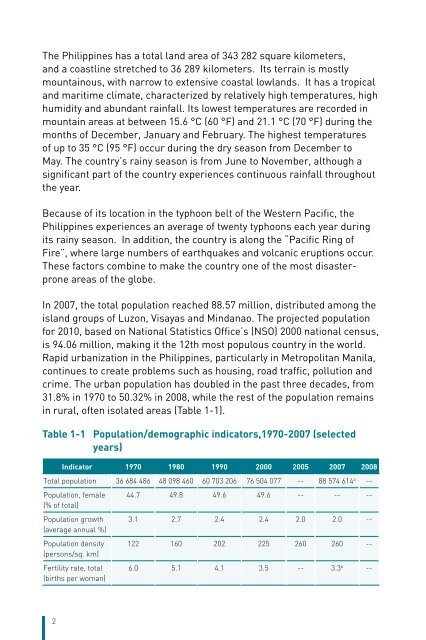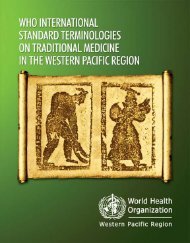The Philippines Health System Review - WHO Western Pacific ...
The Philippines Health System Review - WHO Western Pacific ...
The Philippines Health System Review - WHO Western Pacific ...
- No tags were found...
Create successful ePaper yourself
Turn your PDF publications into a flip-book with our unique Google optimized e-Paper software.
<strong>The</strong> <strong>Philippines</strong> has a total land area of 343 282 square kilometers,and a coastline stretched to 36 289 kilometers. Its terrain is mostlymountainous, with narrow to extensive coastal lowlands. It has a tropicaland maritime climate, characterized by relatively high temperatures, highhumidity and abundant rainfall. Its lowest temperatures are recorded inmountain areas at between 15.6 °C (60 °F) and 21.1 °C (70 °F) during themonths of December, January and February. <strong>The</strong> highest temperaturesof up to 35 °C (95 °F) occur during the dry season from December toMay. <strong>The</strong> country’s rainy season is from June to November, although asignificant part of the country experiences continuous rainfall throughoutthe year.Because of its location in the typhoon belt of the <strong>Western</strong> <strong>Pacific</strong>, the<strong>Philippines</strong> experiences an average of twenty typhoons each year duringits rainy season. In addition, the country is along the “<strong>Pacific</strong> Ring ofFire”, where large numbers of earthquakes and volcanic eruptions occur.<strong>The</strong>se factors combine to make the country one of the most disasterproneareas of the globe.In 2007, the total population reached 88.57 million, distributed among theisland groups of Luzon, Visayas and Mindanao. <strong>The</strong> projected populationfor 2010, based on National Statistics Office’s (NSO) 2000 national census,is 94.06 million, making it the 12th most populous country in the world.Rapid urbanization in the <strong>Philippines</strong>, particularly in Metropolitan Manila,continues to create problems such as housing, road traffic, pollution andcrime. <strong>The</strong> urban population has doubled in the past three decades, from31.8% in 1970 to 50.32% in 2008, while the rest of the population remainsin rural, often isolated areas (Table 1-1).Table 1-1 Population/demographic indicators,1970-2007 (selectedyears)Indicator 1970 1980 1990 2000 2005 2007 2008Total population 36 684 486 48 098 460 60 703 206 76 504 077 -- 88 574 614 a --Population, female(% of total)Population growth(average annual %)Population density(persons/sq. km)Fertility rate, total(births per woman)44.7 49.8 49.6 49.6 -- -- --3.1 2.7 2.4 2.4 2.0 2.0 --122 160 202 225 260 260 --6.0 5.1 4.1 3.5 -- 3.3 b --2
















